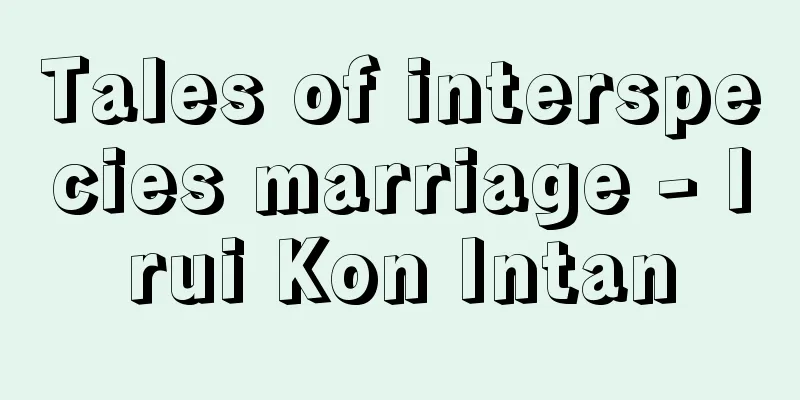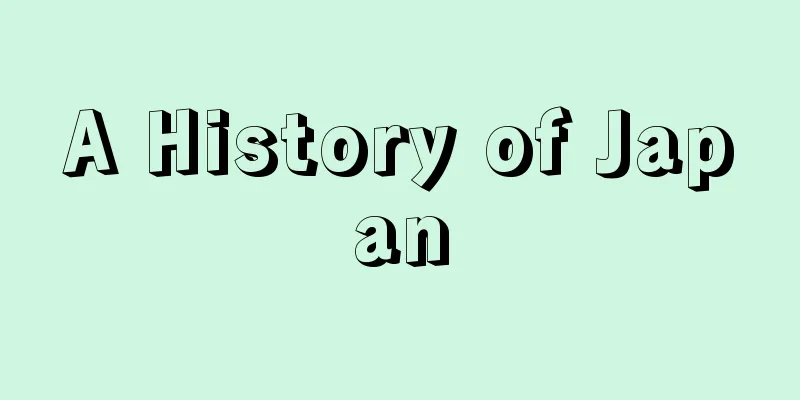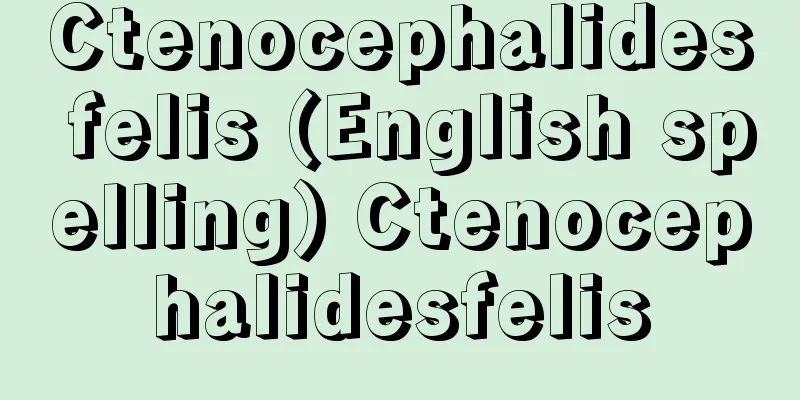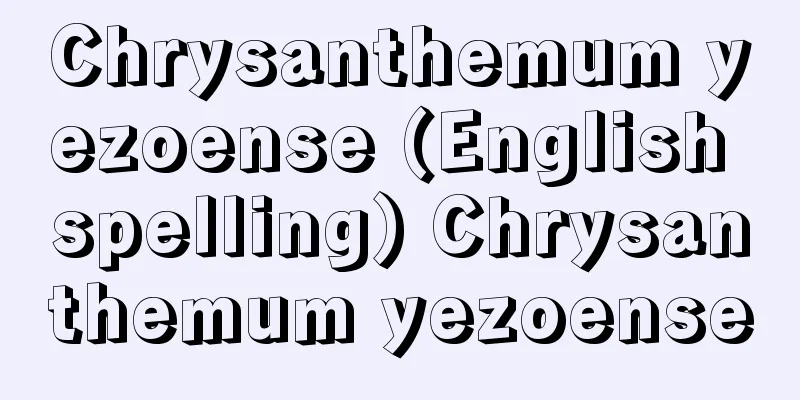Tales of interspecies marriage - Irui Kon Intan

|
A general term for folk tales that have as their theme marriages with non-humans, such as animals, spirits, and monsters. There are two types: (1) when the irui is a woman, and (2) when the irui is a man. (1) includes "Tennin no Nyobo", "Ryugu no Nyobo", "Egazu Nyobo", "Tsuru no Nyobo", "Kitsune no Nyobo", "Hebi no Nyobo", and "Hamaguri no Nyobo". In most cases, the irui marry into the man's family to make them wealthy as a thank you for helping them, but in most cases, they end up bankrupt because the man violates a taboo. (2) includes "Saru Mukōiri", "Kappa no Nyobo", "Oni Nyobo", and "Hebi Nyobo". These also follow a set format. The man promises to give one of his daughters in marriage if the woman brings water into the rice field, but the two oldest daughters refuse, and the youngest daughter marries the irui. The plot involves making the husband, who is a stranger, carry a heavy mortar on his back on the day he returns home from his parents' house, asking for flowers from the treetops, and then drowning the mortar in the river (or killing him by throwing a needle at him). Although the water-begging version of "The Snake Bride" belongs to this line, the other version, the hemp-ring version, is the same as the legend of the divine marriage to Mt. Miwa (Kojiki). The story involves the wife threading a thread through her husband's clothes as he comes by every night, following him, and discovering his true identity. Greek mythology includes "Eros and Psyche," while Grimm's tales include "The Frog Prince," showing that intermarriage with other species is a common theme throughout the world. The other species who make love to humans have the characteristics of gods or spirits who come from another world, and try to keep their offspring in the human world. Some of the "celestial wife," "fox wife," and "fish wife" retain traces of the ancestor legends. This shows that mythological traditions are passed down in old tales. However, in Japanese old tales, marriages often end in breakdown, and the tradition of the birth of the ancestor is established by the denial of the idea of keeping the offspring of other species in the human world. This is the result of the refraction of the traditions in old tales, and should be seen as a fixation on the time when the offspring of animals or monsters were no longer accepted. The main cause of marriage breakdowns is the violation of taboos, which often takes the form of a man peeking out of curiosity at something strange that should not be seen, such as breastfeeding in the birthing room (the snake wife, similar to the story of Toyotamahime in the Kojiki and Nihon Shoki myths), weaving (the crane wife), or bathing (the fish wife). If it was a promise made at the time of marriage, the wife would return to her original form and leave, but we should see an underlying reverence for the place and act when filled with sacred power, with the woman returning to her true form in private. It is related to the awe of the afterlife in the human world. It is thought that there is a motif of breaking the iron law of a super-individual society. Kunio Yanagita considered type (1) to precede type (2), because he saw the inheritance of mythological traditions and ancestor legends as being stronger, as the motif of violation of taboos remains more abundant in this type. In contrast, the sad and cruel end of many of the bridegrooms of different races in type (2) only reminds us of the extreme futility of human life, and makes us consider the shallowness of the story as a folk tale. There is also a theory that sees these two as a reflection of marriage customs. In this case, the transition is from a bride-entry marriage to a bride-entry marriage, so type (2) is considered to be older, but this cannot be determined simply. Folk tales are a complex of various traditions that have been layered over a long period of time. In stories like "The Wife of the Heavenly Being" both coexist in one story, with the first half depicting the visit of the wife of the heavenly being visited and her becoming the man's wife with her feather robe hidden, a reflection of a marriage into marriage, while the second half depicts the groom's visit to heaven and the overcoming of many challenges and trials, a marriage into marriage into marriage, and the connection with marriage customs makes us think about the complexity of the tradition (about 130 stories about the wife of the heavenly being reported in Japan, including a separation type, a heavenly visit type, and a Tanabata union type). Something that does not exist in social customs cannot appear in a folk tale, and the correspondence with the marriage system is also valid depending on how it is analyzed. [Shogo Watanabe] "A Study of the History of Oral Literature" (included in The Definitive Collection of Yanagita Kunio Vol. 6, 1963, Chikuma Shobo) "The Birth of Momotaro" (included in The Definitive Collection of Yanagita Kunio Vol. 8, 1963, Chikuma Shobo) Source: Shogakukan Encyclopedia Nipponica About Encyclopedia Nipponica Information | Legend |
|
動物、精霊、妖怪(ようかい)など、人間以外の者との婚姻を主題とした昔話群の総称。(1)異類が女性である場合と、(2)男性である場合とがある。(1)は「天人女房」「竜宮女房」「絵姿女房」「鶴(つる)女房」「狐(きつね)女房」「蛇女房」「蛤(はまぐり)女房」などで、異類の嫁入る動機が、多くは男に助けられたお礼で夫の家を富ませるが、破綻(はたん)は男の禁忌(タブー)の侵犯がほとんど。(2)は「猿婿入(さるむこい)り」「河童(かっぱ)婿入り」「鬼婿入り」「蛇婿入り」などが代表的なもの。これも型はおよそ決まっている。田に水を入れてくれれば娘の1人を嫁にやると約束して水を引いてもらうが、3人娘の姉2人は嫁入りを拒絶して末娘が異類に嫁す。実家(さと)帰りの日に異類の夫に重い臼(うす)を背負わせ、梢(こずえ)の花を所望して臼ごと川に沈める(あるいは針を投げて殺す)という展開である。ただ「蛇婿入」の水乞(みずご)い型はこの筋に属するが、もう一つ苧環(おだまき)型は三輪山神婚伝説(『古事記』)と同型である。夜ごとに通ってくる夫の衣に糸を通して、その後をつけ、その正体を知るという筋である。 ギリシア神話にも「エロスとプシケ」、グリム説話にも「蛙(かえる)の王子」などがあり、異類との婚姻が世界に共通する主題であることを示している。人間と契る異類たちは、他界から来臨する神もしくは精霊の性格を具備して、その胤(たね)を人界にとどめようとしているし、「天人女房」「狐女房」や「魚女房」の一部は、そのまま始祖伝説の名残(なごり)をとどめている。そこに神話的伝承が昔話のなかに遺伝されている、といえる。しかし、日本の昔話では夫婦が破綻に至るほうが多く、異類の胤を人界にとどめることの否定によって、始祖誕生の伝承が成立しているといえよう。それは、昔話における伝承の屈折の結果で、時代相がもはや動物や妖怪の胤を認めなくなった位置で固定した、とみるべきである。夫婦が破綻となる主因の、禁忌の侵犯は、産屋(うぶや)の授乳(蛇女房。記紀神話の豊玉姫(とよたまひめ)説話に同じ)や機(はた)織り(鶴女房)や沐浴(もくよく)(魚女房)などの見てはならない異類の状態を、男が好奇心をもってのぞくという型が多い。婚姻時の約束であれば、女房は本来の姿に戻って去るのであるが、女性が人目のない所で真の姿に戻っていることに、聖なる力が満たされたときの、場所、行為に対する畏敬(いけい)観が底流にあったとみるべきであろう。 人界における他界への畏怖観とかかわっている。そこには超個人的な社会の鉄則を破ったというモチーフが考えられる。柳田国男(やなぎたくにお)は、(1)の型を(2)に先行して考えたが、それは、この禁忌侵犯のモチーフがより多く残されているための神話的伝承、始祖伝説の遺伝をより濃くみたからである。それに対しての、(2)型の多くの異類の婿たちの哀れで無惨な最期は、人間のあまりの身がってさを思い知らされるだけで、昔話としての時の浅さを考察せしめる。また、この嫁入り・婿入りの二者を婚姻習俗の反映としてみる説もある。この場合には婿入り婚から嫁入り婚に移るわけであるから、(2)型を古いとするわけだが、これも単純に定められない。長い時間に種々の伝承を重層複合しているのが昔話である。「天人女房」などは一話型のなかに両者を併存して、前半に天人女房の来訪、そして羽衣を隠されて男の妻となる、嫁入り婚の反映であるし、後半は婿の天界訪問と多くの難題や試練の克服は婿入り婚のそれであって、婚姻習俗とのかかわりは、伝承の複雑さを考えさせる(天人女房は日本で約130話の報告があり、離別型、天上訪問型、七夕(たなばた)結合型がある)。社会習俗にないものが昔話に現れるわけはないのであって、婚姻制との対応も、分析のいかんによっては有力である。 [渡邊昭五] 『「口承文芸史考」(『定本柳田国男集6』所収・1963・筑摩書房)』▽『「桃太郎の誕生」(『定本柳田国男集8』所収・1963・筑摩書房)』 出典 小学館 日本大百科全書(ニッポニカ)日本大百科全書(ニッポニカ)について 情報 | 凡例 |
<<: Tale of a Different Kind of Wife - Iruinyobotan
Recommend
Ty Cobb
1886‐1961 American Major League Baseball player. H...
Green anole
...The Fiji Iguana, Brachylophus fasciatus , is a...
Altai Steppe
…The fertile black soils encourage agriculture, a...
Academy of American Franciscan History
…Their subsequent activities probably covered the...
Kitaibaraki [city] - Kitaibaraki
A city in the northeastern tip of Ibaraki Prefectu...
Lollards - The Lollards
A general term for followers of the ideas of Wycli...
Plate
...A general term for plate-shaped materials made...
Polysticta stelleri (English spelling)
…A general term for the eider family Anatidae, or...
Dale's principle
…It is generally believed that each neuron synthe...
Aurora
…He studied Kabbalah, alchemy, and theosophy on h...
Chen Jiongming
A warlord in the Republic of China. His courtesy ...
neuroscience
…Neurology is a discipline that was established a...
Kimi Kishigami
...It incorporates Western vocal styles into Japa...
Ryukyu spiny rat (English spelling)
A spiny mouse that belongs to the order Rodentia, ...
Mutual aid system - Kyosaisei-do
...It is an economic system in which people expos...









